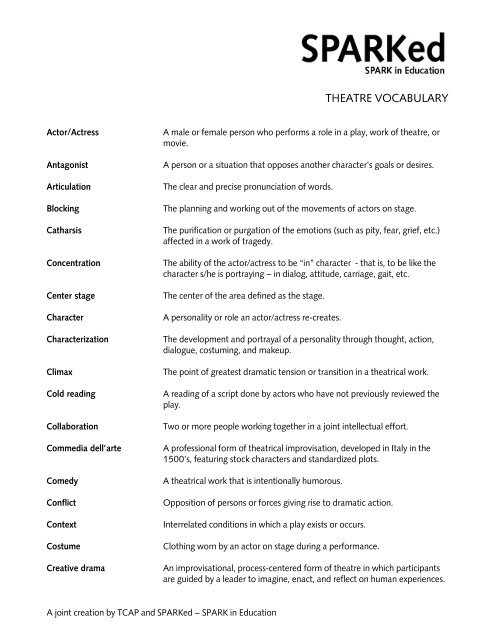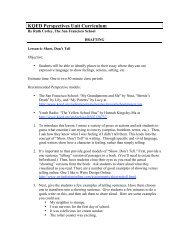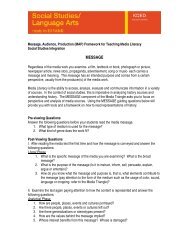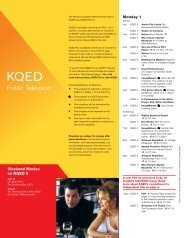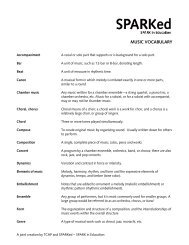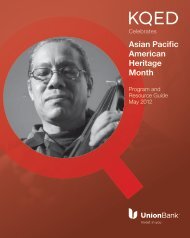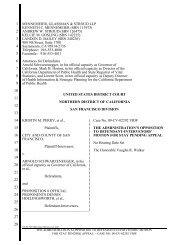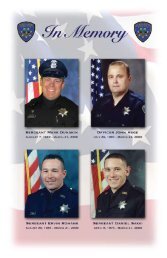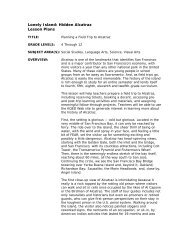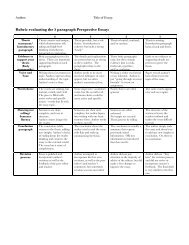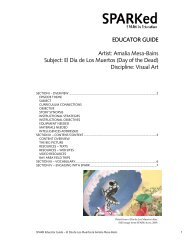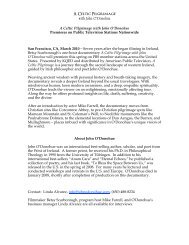THEATRE VOCABULARY - KQED
THEATRE VOCABULARY - KQED
THEATRE VOCABULARY - KQED
Create successful ePaper yourself
Turn your PDF publications into a flip-book with our unique Google optimized e-Paper software.
<strong>THEATRE</strong> <strong>VOCABULARY</strong><br />
Actor/Actress A male or female person who performs a role in a play, work of theatre, or<br />
movie.<br />
Antagonist A person or a situation that opposes another character’s goals or desires.<br />
Articulation The clear and precise pronunciation of words.<br />
Blocking The planning and working out of the movements of actors on stage.<br />
Catharsis The purification or purgation of the emotions (such as pity, fear, grief, etc.)<br />
affected in a work of tragedy.<br />
Concentration The ability of the actor/actress to be “in” character - that is, to be like the<br />
character s/he is portraying – in dialog, attitude, carriage, gait, etc.<br />
Center stage The center of the area defined as the stage.<br />
Character A personality or role an actor/actress re-creates.<br />
Characterization The development and portrayal of a personality through thought, action,<br />
dialogue, costuming, and makeup.<br />
Climax The point of greatest dramatic tension or transition in a theatrical work.<br />
Cold reading A reading of a script done by actors who have not previously reviewed the<br />
play.<br />
Collaboration Two or more people working together in a joint intellectual effort.<br />
Commedia dell’arte A professional form of theatrical improvisation, developed in Italy in the<br />
1500’s, featuring stock characters and standardized plots.<br />
Comedy A theatrical work that is intentionally humorous.<br />
Conflict Opposition of persons or forces giving rise to dramatic action.<br />
Context Interrelated conditions in which a play exists or occurs.<br />
Costume Clothing worn by an actor on stage during a performance.<br />
Creative drama An improvisational, process-centered form of theatre in which participants<br />
are guided by a leader to imagine, enact, and reflect on human experiences.<br />
A joint creation by TCAP and SPARKed – SPARK in Education
Crisis A decisive point in the plot of a play on which the outcome of the remaining<br />
action depends.<br />
Critique Opinions and comments based on predetermined criteria that may be used<br />
for self- evaluation or the evaluation of the actors or the production itself.<br />
Cue A signal, either verbal or physical, that indicates something else, such as a<br />
line of dialogue or an entrance, is to happen.<br />
Denouement The final resolution of the conflict in a plot.<br />
Design The creative process of developing and executing aesthetic or functional<br />
designs in a production, such as costumes, lighting, sets, and makeup.<br />
Dialogue The conversation between actors on stage.<br />
Diction The pronunciation of words, the choice of words, and the manner in which a<br />
person expresses himself or herself.<br />
Directing The art and technique of bringing the elements of theatre together to make<br />
a play.<br />
Director The person who oversees the entire process of staging a production.<br />
Downstage The stage area toward the audience.<br />
Dramatic play Children’s creation of scenes when they play “pretend”.<br />
Dramatic structure The particular literary structure and style in which plays are written.<br />
Dramaturg A person who provides specific in-depth knowledge and literary resources to<br />
a director, producer, theatre company, or even the audience.<br />
Dress rehearsals The final few rehearsals just prior to opening night in which the show is run<br />
with full technical elements. Full costumes and makeup are worn.<br />
Electronic media Means of communication characterized by the use of technology (e.g.,<br />
radio, television, and the Internet).<br />
Elizabethan theatre The theatre of England during the reign of Queen Elizabeth I and often<br />
extended to the close of the theatres in 1640.<br />
Emotional memory The technique of calling upon your own memories to understand a<br />
character’s emotions.<br />
Ensemble A group of theatrical artists working together to create a theatrical<br />
production.<br />
Epic theatre Theatrical movement of the early 1920’s and 1930 characterized by the use<br />
of such artificial devices as cartoons, posters, and film sequences distancing<br />
A joint creation by TCAP and SPARKed – SPARK in Education
the audience from theatrical illusion and following focus on the play’s<br />
message.<br />
Exposition Detailed information revealing the facts of a plot.<br />
Farce A comedy with exaggerated characterizations, abundant physical or visual<br />
humor, and, often, an improbable plot.<br />
Form The overall structure or shape of a work that frequently follows and<br />
established design. Forms may refer to a literary type (e.g., narrative form,<br />
short-story form, dramatic form) or to pattern of meter, line, and rhymes<br />
(e.g., stanza form, verse form).<br />
Formal theatre Theatre that focuses on public performance in the front of an audience and<br />
in which the final production is most important.<br />
Genre In literary and dramatic studies, genre refers to the main types of literary<br />
form, principally tragedy and comedy. The term can also refer to forms that<br />
are more specific to a given historical era, such as the revenge tragedy, or to<br />
more specific sub-genres of tragedy and comedy, such as the comedy of<br />
manners.<br />
Gesture An expressive movement of the body or limbs.<br />
Greek theatre Theatrical events in honor of the god Dionysus in Ancient Greece and<br />
included play competitions and a chorus of masked actors.<br />
Improvisation A spontaneous style of theatre through which scenes are created without<br />
advance rehearsal or a script.<br />
Informal theatre A theatrical performance that focuses on small presentations, such as one<br />
taking place in a classroom setting. Usually, it is not intended for public<br />
view.<br />
Kabuki One of the traditional forms of Japanese theatre, originating in the 1600’s<br />
and combining stylized acting, costumes, makeup, and musical<br />
accompaniment.<br />
Level The height of an actor’s head actor as determined by his or her body<br />
position (e.g., sitting, lying, standing, or elevated by an artificial means).<br />
Make-up Cosmetics and sometimes hairstyles that an actor wears on stage to<br />
emphasize facial features, historical periods, characterizations, and so forth.<br />
Masks Coverings worn over the face or part of the face of an actor to emphasize or<br />
neutralize facial characteristics.<br />
Melodrama A dramatic form popular in the 1800s and characterized by an emphasis on<br />
plot and physical action (versus characterization), cliff-hanging events, heart-<br />
A joint creation by TCAP and SPARKed – SPARK in Education
tugging emotional appeals, the celebration of virtue, and a strongly<br />
moralistic tone.<br />
Mime An incident art form based on pantomime in which conventionalized<br />
gestures are used to express ideas rather than represent actions; also, a<br />
performer of mime.<br />
Monologue A long speech by a single character.<br />
Motivation A character’s reason for doing or saying things in a play.<br />
Musical theatre A type of entertainment containing music, songs, and, usually, dance.<br />
Noh One of the traditional forms of Japanese theatre in which masked male<br />
actors use highly stylized dance and poetry to tell stories.<br />
Objective A character’s goal or intention<br />
Pacing The tempo of an entire theatrical performance.<br />
Pantomime Acting without words through facial expression, gesture, and movement.<br />
Pitch The highness or lowness of voice<br />
Play The stage representation of an action or a story; a dramatic composition.<br />
Playwright A person who writes plays.<br />
Position The orientation of the actor to the audience (e.g., full front, right profile, left<br />
profile).<br />
Projection The placement and delivery of volume, clarity, and distinctness of voice for<br />
communicating to an audience.<br />
Props (properties) Items carried on stage by an actor; small items on the set used by the actors.<br />
Proscenium The view of the stage for the audience; also called a proscenium arch. The<br />
archway is in a sense the frame for stage as defined by the boundaries of the<br />
stage beyond which a viewer cannot see.<br />
Protagonist The main character of a play and the character with whom the audience<br />
identifies most strongly.<br />
Puppetry Almost anything brought to life by human hands to create a performance.<br />
Types of puppets include rod, hand, and marionette.<br />
Rehearsal Practice sessions in which the actors and technicians prepare for public<br />
performance through repetition.<br />
A joint creation by TCAP and SPARKed – SPARK in Education
Rising action The part of a plot consisting of complications and discoveries that create<br />
conflict.<br />
Run-through A rehearsal moving from start to finish without stopping for corrections or<br />
notes.<br />
Script The written text of a play.<br />
Sense memory Memories of sights, sounds, smells, tastes, and textures. It is used to help<br />
define a character in a certain situation.<br />
Stage The area where actors perform.<br />
Stage crew The backstage technical crew responsible for running the show. In small<br />
theatre companies the same persons build the set and handle the load-in.<br />
Then, during performances, they change the scenery and handle the curtain.<br />
Stage direction (See center stage, downstage, stage left, stage right, and upstage.)<br />
Stage manager The director’s liaison backstage during rehearsal and performance. The<br />
stage manager is responsible for the running of each performance.<br />
Stage left The left side of the stage from the perspective of an actor facing the<br />
audience.<br />
Stage right The right side of the stage from the perspective of an actor facing the<br />
audience.<br />
Stock characters Established characters, such as young lovers, neighborhood busybodies,<br />
sneaky villains, and overprotective fathers, who are immediately<br />
recognizable by an audience.<br />
Style The distinctive and unique manner in which a writer arranges words to<br />
achieve particular effects. Style essentially combines the idea to be<br />
expressed with the individuality of the author. These arrangements include<br />
individual word choices as well as such matters as the length and structure<br />
of sentences, tone, and use of irony.<br />
Subtext Information that is implied by a character but not stated by a character in<br />
dialogue, including actions and thoughts.<br />
Tableau A silent and motionless depiction of a scene created by actors, often from a<br />
picture (plural tableaux).<br />
Text Printed words, including dialogue and the stage directions for a script.<br />
Theatre To imitate or represent life in performance for other people; the<br />
performance of dramatic literature; drama, the milieu of actors, technicians,<br />
and playwrights; the place where dramatic performances take place.<br />
A joint creation by TCAP and SPARKed – SPARK in Education
Theatre of the absurd Theatrical movement beginning in the 1950s in which playwrights created<br />
works representing the universe as unknowable and humankind’s existence<br />
as meaningless.<br />
Theatrical conventions The established techniques, practices, and devices unique to theatrical<br />
productions.<br />
Theatrical experiences Events, activities, and productions associated with theatre, film/video, and<br />
electronic media.<br />
Theatre games Noncompetitive games designed to develop acting skills and popularized by<br />
Viola Spolin.<br />
Tragedy Used as a noun, the stage area away from the audience; used as a verb, to<br />
steal the focus of a scene.<br />
Vocal quality The characteristics of a voice, such as shrill, nasal, raspy, breathy, booming,<br />
and so forth.<br />
Volume The degree of loudness or intensity of a voice.<br />
A joint creation by TCAP and SPARKed – SPARK in Education


